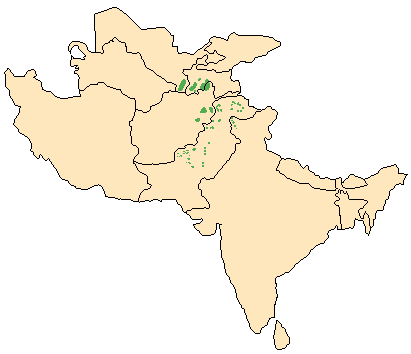![]() Return
to Artiodactyla
Return
to Artiodactyla
Classification
|
 Capra
falconeri
Capra
falconeri
Markhor
![]()
Taxonomy
 |
 |
 |
Click on the pictures above for a larger view of the
photographs
|
||
General Characteristics
Body Length: 132-186 cm / 4.4-6.2 ft.
Shoulder Height: 65-115 cm / 2.1-3.8 ft.
Tail Length: 8-20 cm / 3.2-8 in.
Weight: 32-110 kg / 70-242 lb.The grizzled light brown to black coat is smooth and short in summer, growing longer and thicker in winter. Males have long hair on the chin, throat, chest, and shanks, while females have smaller fringes. The lower legs have a black and white pattern. The tightly curled, corkscrew-like horns are present in both sexes, starting close together at the head, but spreading towards the tips. In males, they can grow up to 160 cm / 64 inches long, and up to 25 cm / 10 inches in females.
Ontogeny and Reproduction
Gestation Period: 135-170 days.
Young per Birth: 1 or 2, rarely 3
Weaning: At 5-6 months.
Sexual Maturity: At 18-30 months.
Life span: 12-13 years.Mating occurs during winter, with the subsequent births occurring from late April to early June.
Ecology and Behavior
The markhor is mainly active in the early morning and late afternoon. During the spring and summer months it is a grazer, while in the winter it turns to browse for nourishment. Markhor often stand on their hind legs in order to reach high vegetation. Population densities in Pakistan range from 1-9 animals per square kilometer. During the rut males fight for breeding rights. These competitions involve lunging and locking the horns, followed by the combatants twisting and pushing in an attempt to make the other lose his balance. The markhor's alarm call resembles the nasal "a" popularized by the common domestic goat.Family group: Females and young live in herds of around 9 animals, adult males are usually solitary.
Diet: Grasses, leaves.
Main Predators: Wolf, snow leopard, leopard, lynx, humans.
Distribution
Sparsely wooded mountainous regions in the western Himalayas at an elevation of 600-3,600 m / 1,900-11,500 ft.

Range Map (Compiled from Shackleton, 1997)
Conservation Status
The markhor as a species is classified as endangered by the IUCN (1996). However, each subspecies has its own ranking: both C. f. falconeri and C. f. megaceros are endangered, while C. f. heptneri is critically endangered.
Remarks
The name markhor is derived from the Persian mar, a snake, and khor, eating. This is a very peculiar name, as these goats are vegetarians. Different interpretations of the name vary from "snake-killer" (a feat which they have been known to do) to a reference to the corkscrewing horns, which are somewhat reminiscent of a snakes winding body. Capra (Latin) a she-goat. Hugh Falconer (1808-1865) was a Scottish palaentologist and botanist in India.
Literature Cited
Hess, R. 1990. Markhor (Capra falconeri). In Grzimek's Encyclopedia of Mammals. Edited by S. P. Parker. New York: McGraw-Hill. Volume 5, pp.529-535.Nowak, R. M. [editor]. 1991. Walker's Mammals of the World (Fifth Edition). Baltimore: The Johns Hopkins University Press.
Shackleton, D. M. [Editor] and the IUCN/SSC Caprinae Specialist Group. 1997. Wild Sheep and Goats and their Relatives. Status Survey and Action Plan for Caprinae. IUCN: Gland, Switzerland and Cambridge, UK. pp. 172-193.
Wilson, D. E., and D. M. Reeder [editors]. 1993. Mammal Species of the World (Second Edition). Washington: Smithsonian Institution Press. Available online at http://nmnhwww.si.edu/msw/
Return to Artiodactyla

![]()
© Brent Huffman, www.ultimateungulate.com |
|
|